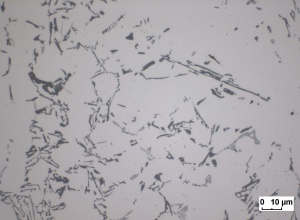Feb 2 2009
Materials with a nanoparticle structure are stronger and harder than materials made of larger particles. A new manufacturing technique ensures that such microcrystalline structures remain intact when being processed.
 Structure of a conventional aluminum alloy. image: Fraunhofer IFAM.
Structure of a conventional aluminum alloy. image: Fraunhofer IFAM.
Aluminum is light but also bends easily. However, if it has a nanometer structure, it features quite different properties: The material is much stronger and firmer, and this makes it ideal for engine screws, which have to withstand high temperatures. It is also eminently suitable for making lightweight parts, for the stronger the material, the thinner the sheets for the components can be made. The material’s properties are mainly due to the tiny size of its crystals. These are much smaller than those in conventional materials, hence the designation “microcrystalline structures”.
One of the challenges posed by such nano materials lies in processing them to make tools or components. Pressing or joining requires that the material be heated. This causes the crystals to grow, so the structures become larger. In short, the material loses its “nano properties” as it heats up. Researchers at the Fraunhofer Institute for Manufacturing Engineering and Applied Materials Research IFAM in Dresden have risen to the challenge. “Our goal is to preserve the material’s microcrystalline structure throughout the entire component manufacturing process,” states IFAM project manager Dr. Ronny Leuschner.
To this end, the researchers have set up a special technology chain for manufacturing nano-structured aluminum and other materials. “First of all, we produce a special aluminum alloy,” says Leuschner. “The metal melt has to be cooled very rapidly, so we virtually freeze it.” This is done using the “melt spinning” technique: A specially developed spraying device pours the melt onto a water-cooled rotating roller, producing uniform strips or “flakes” no more than a few micrometers thick. As soon as it hits the roller, the melt rapidly loses heat and the flakes solidify at top speed.
The advantage of this system is that it can handle several kilograms of material and withstand temperatures of more than 1700 degrees Celsius. “Once they have solidified, the flakes need to be compacted and pressed into the desired shape,” explains Leuschner. During this step, too, their microcrystalline structures must remain intact. The method the researchers use in this case is spark plasma sintering: High-frequency current pulses inside the press compact the material in a very short space of time so that the fine microstructures are preserved. Applications for these nano materials range from lightweight aluminum parts with greater strength and improved wear and corrosion resistance, to hydrogen storage, energy production with thermoelectric materials, and electrical engineering.